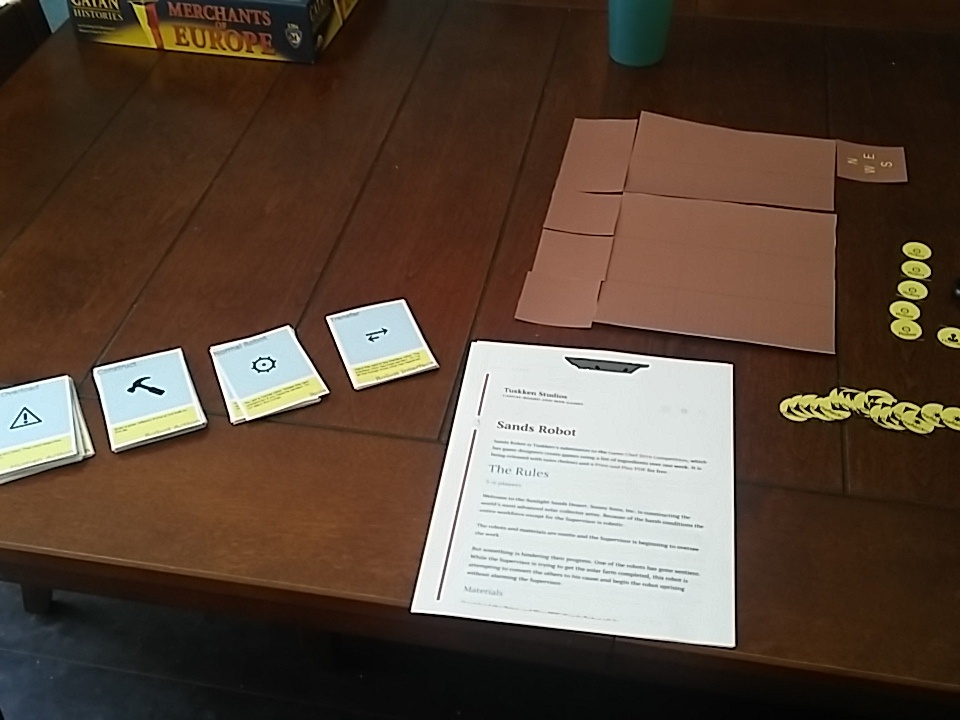
Always trying to explain away what you don’t understand. You mortals are so… fascinating.


Always trying to explain away what you don’t understand. You mortals are so… fascinating.

We had a blatant omission to our submission for Game Chef 2016: Playtesting. Technically, Game Chef 2016 design is over. We’ll need to leave the rules and released materials alone for now while the reviews and judging are going. Still, we’ve got something worth trying so we wanted to give it a shot. The short story is: “Oops, it’s a little broken.” The longer story (below) is that it seems like there’s a fun game in there, with the right tweaks. We’ve got some suggestions if you end up trying to play it as it is today. Once the judging is over, we’ll release an update.
Printing went fine. It looks like the PDF makes for a good (if not quite standard) card and board size. Right off the bat after setup we noticed that the robot pieces have no distinguishing marks. We had to mark them with numbers to tell the robots apart.
When picking the first human, the instructions call for a dice roll. Not that most people don’t have ready access to dice, but they aren’t used anywhere else in the game. We opted to shuffle up the role cards and draw for first human (then reshuffle to distribute robot roles).
The instructions have the human draw cards before removing repair cards and shuffling the deck. Obvious one to figure out, but amidst the other confusing aspects of the instructions, this was a few more minutes of chaos getting going.
Clearly the kind of mundane things that should have been caught ahead of time! So it goes.
We played with four players (fairly standard choice). The first game was with all cards visible (no hiding hands). We didn’t play it all the way to completion, because of the biggest hole we found: nothing really got built! On top of that, it took forever for the first two transfers (triggering repair activation) to occur. Clearly the robot move balance was way off.
Most of what we found were clarification issues. I’ve moved those to the bottom of this post
About halfway through we decided we understood the rules enough, and were getting annoyed with how little was actually happening. Time to play right, with some fixing up.
The lack of real action made a few adjustments necessary:
Both are crucial to making the game a little more lively.
The second game played fairly well. We had one major snag- we had the hardest time keeping track of which robot went next. In the end, my son lent us a hand in the form of a turn marker:

Sands Robot playtesting turn marker
Beyond that, gameplay went pretty well. We robots managed to get enough transfers going early to hide any obvious conclusions of who was who. The human for the round got a lucky break when a second repair against me failed after a first succeeded, ruling me out entirely. She ended up correctly identifying the sentient robot about 20 minutes in. Not a bad little round.
Still, it was unanimous that the reflectors weren’t doing anything. Even with the change of building on move, less than a quarter of the board ended up built on. We made a drastic change for the next game. But first…
It was quite challenging to keep information hidden. An idea I abandoned early, privacy screens, nearly came back into the picture. We found a solution to the problems that arose, although more likely exist. So far, the game seems to rely on players willing to stick to the spirit of the game to work. Regardless, here’s what we learned:
We had time for one more game. Building was doing essentially nothing; neither was moving. So we confined quarters a little. The board got stripped way down to a 3×3 square. We kept the same rules about building on move, so now it was a little more likely that the board might get filled.
It was also clear that there wasn’t quite enough pressure not to waste repair cards. We removed one from the 4 player game, down to 5 repair cards for three robots. This turned up the pressure quite a bit, since it removed quite a few simple logical tests to find the sentient robot. As a consolation, we did away with the multiple-repair rule and allowed back-to-back repairs against the same robot. After all, its a pretty big gamble to go two repairs deep into one robot unless you’re already sure.
This game played really well. I was the human. I found myself trying to track more information than I could to determine who the sentient robot was. In the end, all I could remember was which transfers had occurred and a few File Browsers I had done early on. My strategy was to herd the robots into the transfers I wanted to test. I got a lucky break when I was able to pin one robot for four turns and keep the other two interacting and giving away information.
Towards the end of the game, once it was clear I was close to figuring out the sentient robot, the tension of the game let up a little early. The robots began malfunctioning a lot just to sabotage the possibility that I could wait out the factory build. I think the next play will add this as a mechanic; once the repair cards come into play, the robots can win by destroying all solar collectors.
Below are the remaining clarifications that were discovered:

Tuskken has officially entered Game Chef 2016. Check out our submission, Sands Robot, which is available for free as a Print and Play game. For more information about Game Chef, check out this year’s theme and ingredients.
We’re pretty happy with how it turned out as far as an idea. Designing something up in a week turned out to be quite the challenge. It took until 4 days in to have a complete ruleset, which is far beyond what I would have expected. From there, I brought the rules in to work and let the board game enthusiasts poke holes in it. There’s a pretty good contingent playing Risk Legacy in the lunchroom, so we had the luxury of a good focus group. The feedback proved useful and showed some early holes in the game.
From there, the details of the cards and board had to be fleshed out. This was my first experience using Card Maker, it was an absolute lifesaver at this point. I’ll be donating for sure. There are lots of claims about stability issues in the release, but it worked far better than half the commercial software you actually pay for. Damn fine work.
Anyway, I didn’t have drafts together until Friday. There’s a board game club near me on Camp Pendleton that just happened to have its monthly meeting on Saturday. A friend said I should bring it for playtesting, but I don’t totally feel right showing up asking for feedback when I have only been once before (and missed a few meeting since). Reluctantly, I agreed. The baby (who is 9 weeks right now) decided any plans of leaving the house would be unacceptable. Scenarios on paper had to suffice as our testing. This caught quite a few things and I think we created something that’s probably not broken. Hopefully we find out someday.
The poor art. Card Maker set everything up nicely, ready for Paul to blast in better images.The card listing wasn’t finalized until Friday, which I’m pretty sure is way too fast to try to put together decent artwork. Event still, just as everything was ready, a nasty illness took Paul out of commission. So, we get to see what happens when I muddle through with GIMP and Googling things like “unicode lightning bolt” to find icons. It could be worse.
Sands Robot is being released as version 0.2. Drop a note in the comments here if you decide to try it out! This game turned out pretty good, I think it might have a future beyond the design competition.
We wish everyone luck this year in Game Chef. In the spirit of the competition, congratulations to all for getting their entries done.
![1374088_699858136708727_1367539549_n[1]](http://tuskken.com/wp-content/uploads/2016/06/1374088_699858136708727_1367539549_n1.png)
Finally, you can play Letteretti for free in your browser.
I was shocked to discover, when I finished this port, that Letteretti was originally written almost five years ago in 2011. It’s come a long way since then. Most amusing is the massive graphical upgrade thanks to Paul:
This wasn’t our first collaboration, but its the first one that actually got finished.
Part of the addition of Paul’s graphics was reworking the whole thing to be HTML/CSS-based to enable easy porting to iPhone, etc. That made this latest port a breeze, mainly a refresher in node.js/Express.
The best part about the browser version is playing with a real keyboard. Since the beginning it has been keyboard-enabled. My original development was using an old Motorola Droid with a slide out keyboard:
(Side note, I forgot how much I enjoyed having the keyboard option on a smartphone). I’m not sure anyone has ever actually used the keyboard feature except me.
I’m hoping to add a few more features in the coming weeks, but its up and playable!